Your Call?
Which is the strongest of today’s three 1200mm featured images? Please leave a comment and let us know why you made your choice. I have a very clear winner that I will share with your here soon.
|
|
|
Clockwise from the upper left back around to center: Osprey gaining altitude after missed strike; school of mullet under attack from below; Wood Stork with Southern Whiting; Osprey with Menhaden; Wood Stork with small lobster; Royal Tern with large baitfish; Osprey with Menhaden; juvenile Osprey directly overhead “t-shot”; Osprey taking flight with freshly caught Mullet. |
Sebastian Inlet In-the-Field Sessions
Join me for 3 hours of morning In-the-Field Instruction at Sebastian Inlet for only $300.00/session. The main target will be fishing Ospreys hunting for a variety of migrating saltwater fish that visit the inlet each fall. Back-up subjects include fishing gulls, terns, and Brown Pelicans, Wood Stork, a variety of herons and egrets, shorebirds, sunrise cloud-scapes, and the occasional sea turtle or manatee.
Best Current Dates: Saturday 2 December 2023.
Please get in touch via e-mail or call my cell at 863-221-2372 ASAP to book one or more sessions. Please shoot me a text if I do not pick up.
Most photographers visit Sebastian Inlet with eyes only for Osprey. When the Osprey action is lacking, there are lots of other great avian subjects to shoot. The fact is, however, that most photographers ignore the other birds. And if on occasion, they get so bored by the lack of action that they point their lenses at the gulls, terns, shorebirds, and wading birds, they carelessly work well off sun angle with total disregard for the wind.
As mentioned previously, the key to making superb photographs at Sebastian (or anywhere else), is to understand the relationship of the wind strength and direction, the sky conditions, and the direction and quality of the light. Learn to do just that by joining me this Saturday morning (tomorrow, 2 DEC) at Sebastian. The morning forecast is again dead-solid perfect. The tide is perfect as well.
What’s Up
I had a great morning on Thursday driving around in my BMW X-5. I worked the whole time at 1200mm off the BLUBB. I began with a handsome adult Turkey Vulture on The Perch. And then, things got better!
Today is Friday 1 December 2023. It is 5:10am as I type in the car. I got to sleep very early and got out of bed at 3:40am. Jim is kindly driving me to Sebastian Inlet. By the time you read this, I am hoping to be photographing an Osprey coming out of the water with a large catch. The forecast is perfect. If I have a good morning, I will head back tomorrow on my own as Jim goes home today around midday.
Wherever you are and whatever you choose to do, I hope that you too have a great day.
Please remember to use the B&H and Amazon links that are found on most blog pages and to use the BIRDSASART discount code at checkout when purchasing your new gear from Bedfords to get 3% back on your credit card and enjoy free second-day air FedEx. Please, also, consider joining a BAA IPT. You will be amazed at how much you will learn!
You can find some great photo accessories (and necessities, like surf booties!) on Amazon by clicking on the Stuff tab on the orange/yellow menu bar above. On a related note, it would be extremely helpful if blog-folks who, like me, spend too much money on Amazon, would get in the habit of clicking on the Amazon logo link on the right side of each blog post when they shop online. As you might expect, doing so will not cost you a single penny, but would be appreciated tremendously by yours truly. And doing so works seamlessly with your Amazon Prime account.
If an item — a Delkin flash card, or a tripod head — for example, that is available from B&H and/or Bedfords, is also available in the BAA Online Store, it would be great, and greatly appreciated, if you would opt to purchase from us. We will match any price. Please remember also to use my B&H affiliate links or to earn 3% cash back at Bedfords by using the BIRDSASART discount code at checkout for your major gear purchases. Doing either often earns you free guides and/or discounts. And always earns my great appreciation.
B&H Simplified
To ensure that I get credit for your B&H purchases, you can always click here. The tracking is invisible but greatly appreciated. And, you can use your PayBoo card. You must use the website to order. B&H will reopen on Fri April 14. Thanking me for the past 4000 educational blog posts could not be any easier and will not cost you one penny. Please shoot me your B&H receipt for major purchases.
Bedfords Simplified
Click here to start your search. Choose standard shipping, and when you get to the payment page, enter BIRDSASART in the discount code box and hit apply. You will be upgraded to free second day air Fed-Ex and receive 3% cash back on your credit card once your stuff ships. Either is greatly appreciated by yours truly.
B&H
Many folks have written recently stating that they purchased a Sony a1 from B&H and would like their free membership in the Sony 1 Info and Updates Group, a $150.00 value. When I check my affiliate account, their orders have not been there. When I let them know that they get credit for B&H purchases only if they use one of the many B&H affiliate links on the blog or begin their searches with this link, they are always disappointed. If in doubt, please contact me via e-mail and request a BH link. I am always glad to help and to guide you to the right gear.
Bedfords Amazing BAA Discount Policy
Folks who have fallen in love with Bedfords can now use the BIRDSASART coupon code at checkout to enjoy a post-purchase, 3% off-statement credit (excluding taxes and shipping charges) on orders paid with a credit card. The 3% credit will be refunded to the card you used for your purchase. Be sure, also, to check the box for free shipping to enjoy free Second Day Air Fed-Ex. This offer does not apply to purchases of Classes, Gift Cards, prior purchases.
Visit the Bedfords website here, shoot Steve Elkins an e-mail, or text him on his cell phone at (479) 381-2592.
Important Note
As an Amazon Associate, I earn a small percentage when you purchase from Amazon after using any of the Amazon links on the blog (including the logo-link on the right side of each blog post page). My affiliate link works fine with Amazon Prime and using it will not cost you a single cent. Huge thanks, BTW 🙂


Gear Questions and Advice
Too many folks attending BAA IPTs and dozens of photographers whom I see in the field and on BPN, are — out of ignorance — using the wrong gear, especially when it comes to tripods and more especially, tripod heads. And the same is true in spades when ordering new camera bodies or lenses. My advice will often save you some serious money and may help you avoid making a seriously bad choice. Please know that I am always glad to answer your gear questions via e-mail. If you are desperate, you can try me on my cell at 863-221-2372. Please leave a message and shoot me a text if I do not pick up.
|
|
|
This image was created on Thursday 30 November 2023 down by the lake near my home at Indian Lake Estates, FL. Working from the driver’s seat with the lens on a BLUBB, I used the Sony FE 600mm f/4 GM OSS lens, the Sony FE 2.0x Teleconverter, and The One, the Sony Alpha 1 Mirrorless Digital Camera). The exposure was determined via Zebra technology with ISO on the thumb dial. ISO 1600. 1/640 sec. at f/13 (stopped down 1 1/3 stops) in Manual mode. When evaluated in RawDigger, the raw file exposure was determined to be perfect. AWB at 8:08:14am on sunny morning. Tracking: Expand Spot/AF-C with Bird Face/Eye detection enabled performed perfectly even at 1200mm. Be sure to click on the image to enjoy a high-res version. Image #1: Turkey Vulture adult head portrait |
Getting Close
There is a fairly large picnic shelter with about eight large tables and a big barbecue to the south of the bathroom building near the base of the pier. It is surround by sawed off pilings. The vultures love scrounging around searching for scraps of left-over food and on most mornings there will be a few of each vulture species perched either on the pilings or the roof.
To get on sun angle at point blank range, I placed the lens on the BLUBB before beginning my approach. That to avoid scaring any of the perched birds. Then I moved my vehicle forward as slowly as possible while not moving my head at all and holding my breath till I got in the perfect spot.
For this image I had raised the driver’s side window about three inches so that I was on the same level as the perched bird.
As is often the case with vultures, the skin on the head was a mess. Vultures are scavengers and their favorite meals are rotten, smelly, decomposing fish or animal carcasses. It their heads were feathered, it would be impossible to keep them anywhere near clean. The mess cleaned up nicely with the new Remove Tool. Speaking of Digital Basics III Video Series, the Volume I/#2 video was distributed on Wednesday. Details on purchasing that single video will be published here soon.
Aperture Question
Why f/13 for Image #1?
|
|
|
This image was created on Thursday 30 November 2023 down by the lake near my home at Indian Lake Estates, FL. Working from the driver’s seat with the lens on a BLUBB, I used the Sony FE 600mm f/4 GM OSS lens, the Sony FE 2.0x Teleconverter, and The One, the Sony Alpha 1 Mirrorless Digital Camera). The exposure was determined via Zebra technology with ISO on the thumb dial. ISO 1600. 1/2000 sec. at f/8 (wide open) in Manual mode. When evaluated in RawDigger, the raw file brightness was determined to be dead-solid perfect. AWB at 8:20:45am on sunny morning. Tracking: Zone/AF-C with Bird Face/Eye detection enabled performed perfectly even at 1200mm. Be sure to click on the image to enjoy a high-res version. Image #2: Mottled Duck flapping after bath |
Mottled Ducks
Mottled Duck, the Florida Mallard, is common at ILE but difficult to get close to. I noted about six or eight of them swimming around south of the pier. Several were bathing. I positioned the car well back. The bird in Image #2 was off by himself. When he began dipping his breast in the lake I got excited as I knew that 95% of the time a bird will flap after bathing. I was in perfect position, not too close, so that I could get the front flaps and the back flaps without clipping any wings. I had two very similar front-flap images from a 70-frame series. This was the pick of the litter because the greenish/blue/aqua speculum was lit so evenly rendering the colors very bright.
L-TAT, the Luminance Targeted Adjustment Tool, enabled me to get the water and the speculum just as I saw and wanted them. I use this new Photoshop Tool on pretty much every image that I process. Details are of course available in the Digital Basics III Video Series. New folks will of course receive all of the published videos in Volume I.
For this image I had raised the driver’s side window about five inches so that I could be comfortable while photographing the ducks.
|
|
|
This image was created on Thursday 30 November 2023 down by the lake near my home at Indian Lake Estates, FL. Working from the driver’s seat with the lens on a BLUBB, I used the Sony FE 600mm f/4 GM OSS lens, the Sony FE 2.0x Teleconverter, and The One, the Sony Alpha 1 Mirrorless Digital Camera). The exposure was determined via Zebra technology with ISO on the thumb dial. ISO 800. 1/640 sec. at f/9 (stopped down 1/3-stop) in Manual mode. When evaluated in RawDigger, the raw file brightness was determined to be dead-solid perfect. AWB at 8:29:03am on sunny morning. Tracking: Expand Spot/AF-C with Bird Face/Eye detection enabled performed perfectly even at 1200mm. Be sure to click on the image to enjoy a high-res version. Image #3: Red-shouldered Hawk atop long dead Cabbage Palm trunk |
Never Before
In the past, I would never have taken a single image of this bird because there was a photo wire right behind it. I knew that the new Remove Tool would deal with that easily. And it did.
For this image I had raised the driver’s side window about seven inches because the bird was perched on the relatively high stump. As always when working on the BLUBB, I moved the Direct Manual Focusing (DMF) switch to OFF so as to avoid throwing off the focus by inadvertently throwing off the focus when framing the image.
|
|
The Digital Basics III Video Series |
The Digital Basics III Video Series
I realized about a year ago that my digital workflow had changed significantly and was toying with the idea of writing a Digital Basics III. More recently, I have learned and begun working with two great new Photoshop Tools, the Remove Tool and the Luminance Targeted Adjustment Tool. The former is like a smarter Spot Healing Brush Tool on steroids and the latter is a huge step up from the fabulous Color Mixer Tool. During that same time frame, I came up with a new and improved 2-step noise reduction technique. I still use Divide and Conquer, Quick Masks, Layer Masks, an expanded array of personalized keyboard shortcuts, and tons of other stuff from both versions of Digital Basics.
As soon as I realized that I did not want to take on another large writing project, I realized that by creating a series of videos I could much more easily share all the details of my current digital workflow and much more easily incorporate additional new tips, techniques, and tools as I went. And so, The Digital Basics III Video Series was born. You can check out Volume I/#1 here.
You might opt to purchase single videos or to subscribe to Volume I and save $26 by ordering the first five videos in one fell swoop. You can purchase the five videos in Volume I by clicking here. The videos will be most valuable for folks using the latest version of Photoshop (2024) or Lightroom along with Topaz DeNoise AI and Topaz Sharpen AI.
Typos
With all blog posts, feel free to e-mail or to leave a comment regarding any typos or errors.

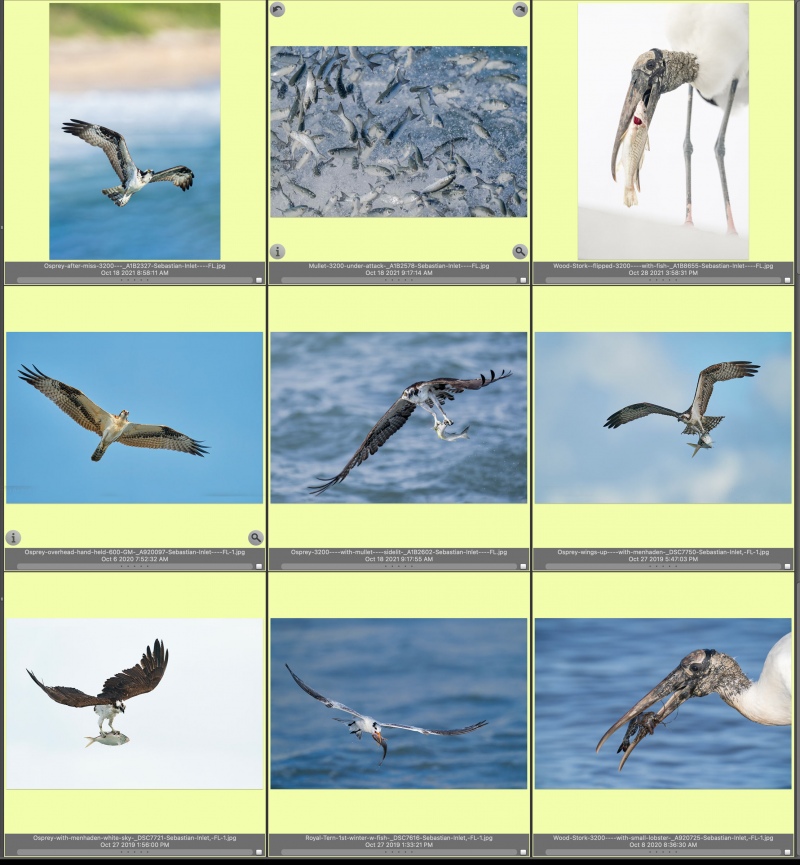

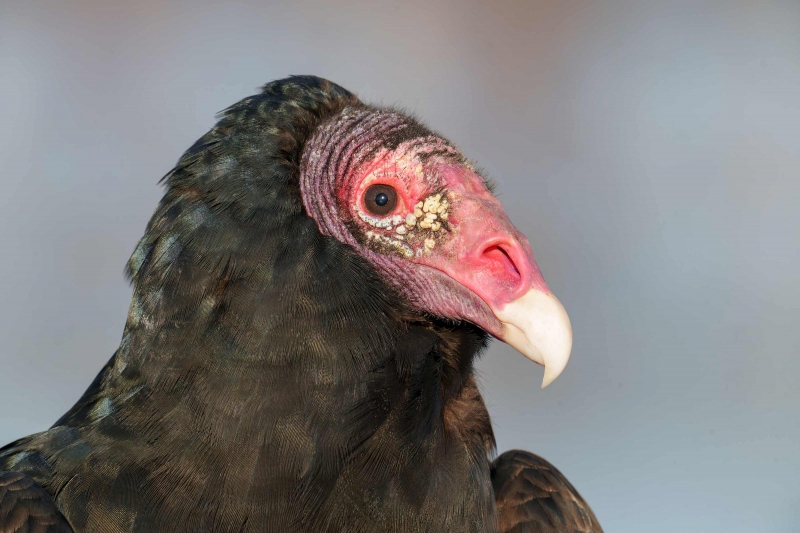
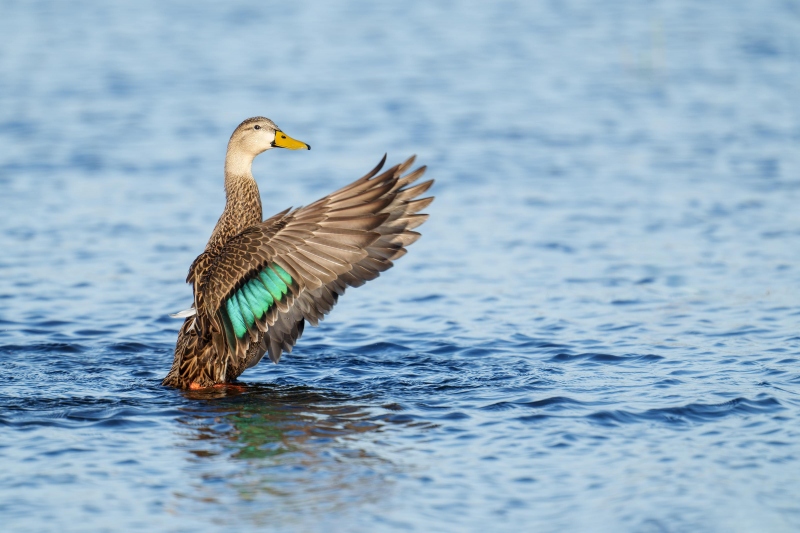
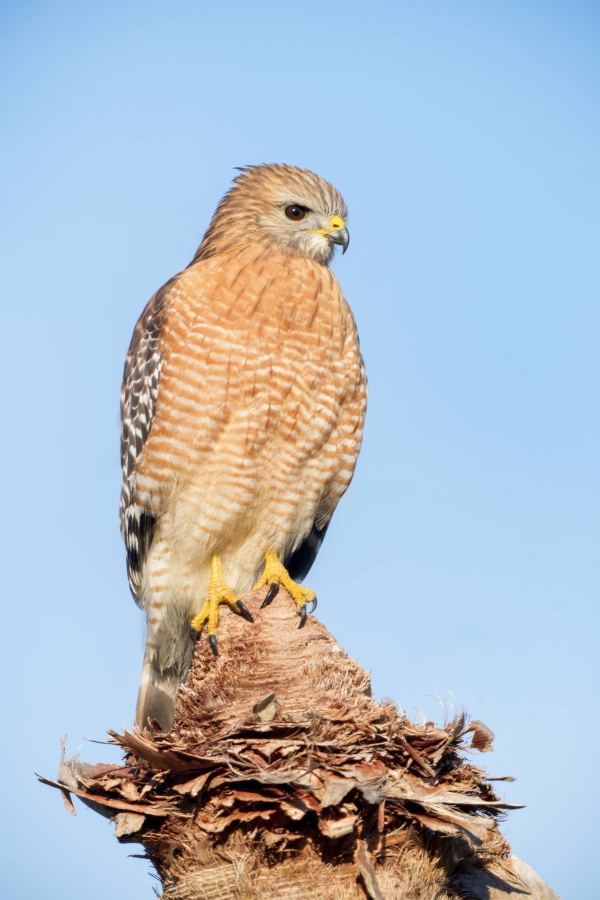
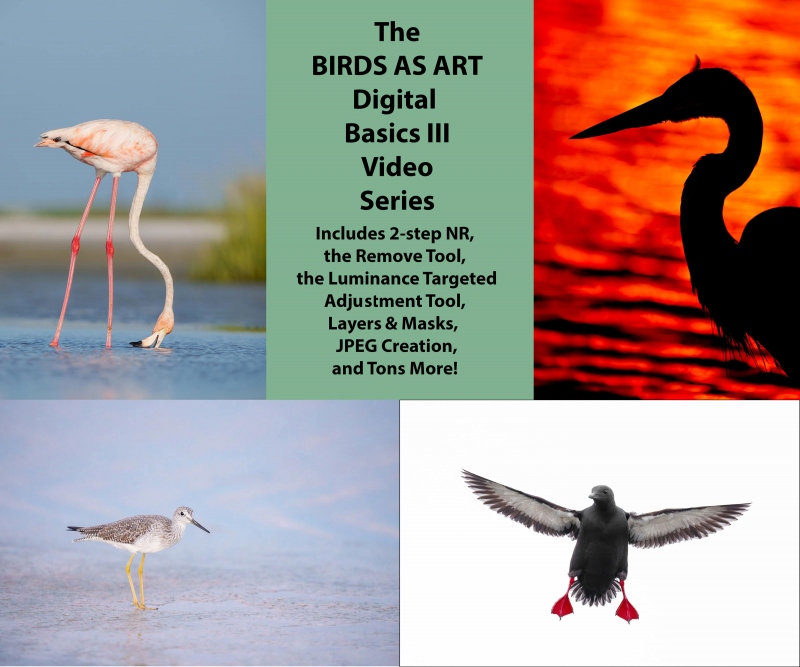













I’m with Joel. On-line DofF calculator shows 1200 mm at F/12.7 and 35 feet (just a guess, but it does not change very much) is 0.09 feet in front and also in back of the plane of focus. That’s about an inch either side. Nice shots. I’m partial to the hawk, but that’s just me.
Thanks for all your work in putting this out there for us. All the best.
Hey Guy, Both correct on the d-o-f question.
And BTW, thanks for your kind words. I am inspired when folks are moved to leave a comment.
with love, artie
F/13 on the first image because you were so close the depth of field was very thin, you stopped down a bit to cope with that is my guess. The subsequent loss of shutter speed didn’t hurt as the subject was relatively still.
You are correct sir. Which image did you like best?
with love, artie
#1 …. love close portraits of birds because it reveals interesting and amazing details that just can’t be seen any other way.
Image #1 Turkey Vulture adult and Image #2 Mottled Duck flapping after bath and Image #3 Red-shouldered Hawk are all well made and interesting! And the other image that shows 8 birds and a lot flying is interesting and well made!
Sue,
I am shocked!
with love, artie